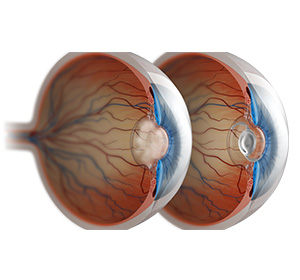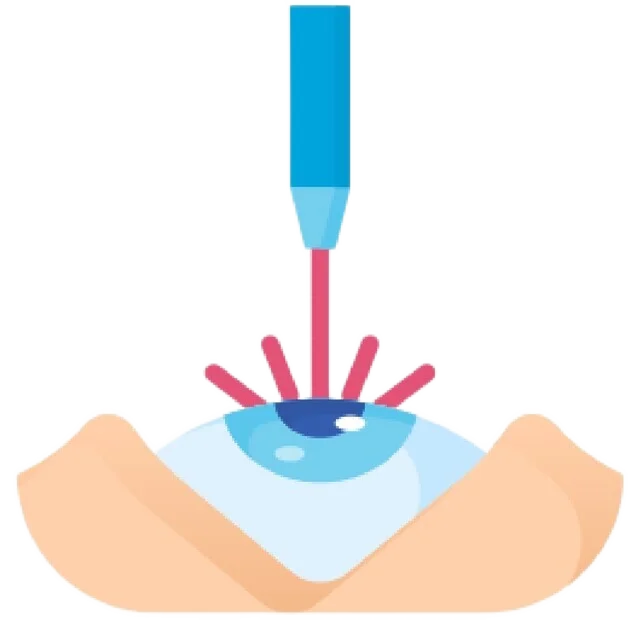
Welcome to Mr. Mo Majid’s Eye Care Clinic in Newport!
Are you experiencing blurry or cloudy vision? Are everyday tasks such as reading, driving, or recognising faces becoming more challenging? If so, you may be dealing with cataracts. Don’t let cataracts hinder your quality of life—Mr. Mo Majid, will help you to regain your vision like never before. He provides Standard & Premium Cataract Surgeries in Bristol, Newport, Cardiff and Swansea.
Standard Cataract Surgery - Newport
Standard cataract surgery, also known as phacoemulsification, is a common surgical procedure used to remove a cataract, which is a clouding of the natural lens of the eye. During the surgery, the cloudy lens is replaced with an artificial intraocular lens (IOL) to restore clear vision.
Here is a general overview of the standard cataract surgery procedure:
- Anesthesia: Before the surgery begins, the eye surgeon will administer local anesthesia to numb the eye. In some cases, general anesthesia may be used.
- Incision: The surgeon will create a small incision on the side of the cornea, the clear, dome-shaped surface at the front of the eye. This incision is usually around 2-3 millimeters long.
- Capsulotomy: A circular opening is made in the front portion of the lens capsule, which is a thin, transparent membrane that surrounds the lens. This opening allows access to the cataract-affected lens.
- Phacoemulsification: A tiny ultrasound probe is inserted into the eye through the incision. The probe uses high-frequency sound waves to break up the cataract into small fragments, which are then suctioned out of the eye.
- IOL Placement: Once the cataract is removed, the artificial intraocular lens (IOL) is inserted through the same incision. The IOL is folded or rolled to fit through the small incision and then unfolds or unrolls once inside the eye. The IOL is positioned in the same location where the natural lens used to be.
- Closure: The incision is usually self-sealing and does not require stitches. It will heal on its own over time.
- Post-operative care: After the surgery, the patient may be given eye drops or medications to prevent infection and reduce inflammation. A protective shield may be placed over the eye for a short period, and the patient will be advised on how to care for their eye during the recovery period.
Premium Cataract Surgery - Newport
Premium cataract surgery refers to a type of cataract surgery that includes additional options or advanced technology beyond the standard procedure. These options aim to enhance the patient’s vision and reduce dependence on glasses or contact lenses after the surgery. While the specific options may vary, here are some common features of premium cataract surgery:
Here are options available for Premium cataract surgery:
- Advanced intraocular lens (IOL) options: Mr. Majid performs Premium cataract surgery often includes the use of advanced IOLs that offer additional benefits compared to standard monofocal IOLs. These advanced IOLs can correct astigmatism, provide a range of vision (multifocal or extended depth of focus), or correct presbyopia (loss of near vision).
- Toric IOLs: These specialised IOLs correct astigmatism, which is a condition that causes distorted or blurry vision due to an irregularly shaped cornea. Toric IOLs can help reduce or eliminate astigmatism, resulting in clearer vision without the need for glasses or contact lenses for distance vision.
- Multifocal or Extended Depth of Focus (EDOF) IOLs: These IOLs are designed to provide a range of vision, including clear vision at various distances (near, intermediate, and distance). They reduce or eliminate the need for glasses after cataract surgery, enabling patients to see clearly at different focal points.
- Wavefront technology or aberrometry: These technologies are used to measure and map the unique characteristics of a patient’s eye, including irregularities or aberrations that may affect vision quality. This information can guide the selection and placement of the IOL, leading to optimised visual outcomes.
- Advanced diagnostics: Premium cataract surgery may include comprehensive pre-operative diagnostics to evaluate the overall health of the eye and to customise the surgical plan accordingly. This may involve the use of advanced imaging technologies to assess the cornea, lens, and other eye structures.
Mr. Majid understand requirement of his patients well to offer specific options for premium cataract surgery that suits well to patients without involving any risk and optimised the surgery costs as well to fulfill all the expectations.
Standard Cataract Surgery
Mr. Mo Majid is an Expert Retinal, and Cataract Surgeon in Bristol, Newport, Cardiff and Swansea.
He provides a one-stop solution for a range of eye conditions and surgical procedures, including routine, complex and premium cataract surgery.
At Mr. Majid’s Eye Care Clinic, what matters the most is the thorough and proper treatment of all conditions of the eye. Amongst the various services available at his clinic, cataract surgery is one of the most widely performed procedures.
Standard cataract surgery is a procedure whereby a patient’s natural lens of the eye (also called the crystalline lens) is removed, if it has developed an opacification. This opacification is also known as cataract. Cataract might result from metabolic changes of the crystalline lens fibres over time, age related changes or certain environmental factors. In this surgery a patient’s natural cataract is removed through emulsification and an artificial intraocular lens (IOL) is implanted in its place.
A standard lens provides a single focus of vision (usually for distance), but not a full range of distances as with Premium lenses.
Phacoemulsification followed by post op recovery is now the standard procedure in cataract surgery all over the world, but in expert hands it can be tweaked to provide even better results than previously. Hence, we follow this updated procedure with utmost precision and expertise for the satisfaction of his patients.
At Mr. Majid’s eye care clinic cataract surgeries are performed in a very controlled and regulated environment. Surgeries at his clinic in Bristol, Newport, Cardiff and Swansea have been successful in helping his patients deal with loss of transparency, impairment or loss of vision.
Premium Cataract/Lens Surgery
Along with standard cataract surgery, Mr. Majid offers premium cataract surgery in Bristol, Newport, Cardiff and Swansea with advanced lenses to give much more accurate corrections for distance and near vision.
In this process instead of the early mono-focal intraocular lenses, advanced multifocal IOLs are implanted to replace the cloudy natural lenses. Before these premium lenses, patients were unable to see clearly at both near and far distances without the use of eye glasses or contact lenses, but with the help of premium cataract surgeries at his Eye Care Clinic patients have been enabled to see clearly at all distances.
This procedure also helps in correcting astigmatism, so that vision without glasses is as clear as it can possibly be- this is where the skill of your surgeon counts!
Mr. Majid’s patients often, fondly call him ‘Mr. Magic’ and with good reason! We use advanced technologies and surgical skill to provide the latest multifocal IOL’s for his patients for the best possible results.
Mr. Majid’s clinic provides several different types of premium lens implants to deal with varied eye conditions.
Mr. Majid will personally provide you with full assistance to help you decide which lens is best suited for your individual condition and will help you in enjoying long lasting clear vision at near, intermediate and far distance.
What are the Treatments for Cataracts?
Surgery is the only treatment for cataracts and is recommended based on the severity of the condition and the impact it has on the daily activities of the patient. It is performed one eye at a time with a few weeks gap in between the two operations. The different types of cataract surgery are performed on an outpatient basis, under local anaesthesia.
Different type of Surgery for Cataract Treatments
Advanced Phacoemulsification
Phacoemulsification uses ultrasound vibrations to break up the damaged lens of the eye. Your surgeon will make a small incision of about 3-5 mm on the side of the cornea, and insert a device to break up and suction out the lens. The lens will be replaced by a man-made lens. The incision heals on its own and does not require any eye-patch or stitches. This surgery takes less than 30 minutes.
Micro incision Cataract Surgery (MICS)
Micro incision cataract surgery (MICS) is minimal invasive cataract surgery, performed by making an incision of less than 1.8 mm. The lens is removed by the phacoemulsification procedure and is implanted with a MICS intraocular lens. MICS is associated with decreased postoperative complications such as corneal aberrations (scratch on the corneal surface) and corneal astigmatism (irregular curvature of the cornea).
Secondary Lens Implantation
Complex cataract surgery or injury can sometimes make it difficult for the surgeon to immediately replace the damaged lens with a plastic lens in your eye. You may have to wear prescription lenses until your eye heals.
Following this, your doctor will suggest a second surgery for lens implantation. This is called secondary lens implantation. Your surgeon will make a small incision in the white part of your eye (sclera) and insert a lens implant. The implant is stitched to the sclera and the incisions are closed with small stitches.
Small-incision Cataract Surgery (SICS)
Small-incision cataract surgery (SICS) involves an incision of around 6-7 mm made in the form of a tunnel through the sclera and cornea. The lens is removed and replaced with a rigid lens implant through this tunnel. No sutures are needed as the tiny incision will heal naturally. It is a low-cost procedure compared to phacoemulsification and ensures good post-operative outcomes.







